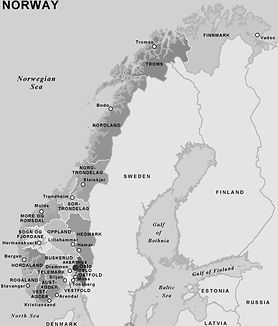
Easy-to-Learn
"Talk sometimes in a foreign language, not to forget how bad you know it."
- Boleslav Paszkowski
Languages
NORWEGIAN
Norway shares a long eastern border with Sweden. Norway is bordered by Finland and Russia to the north-east, and the Skagerrak Strait to the south, with Denmark on the other side.

A few Funny Facts about
the Kingdom of Norway
and the Norwegian language
1. If you have a Norwegian-English dictionary and an English-Norwegian dictionary, the second will be a LOT bigger. Norwegian has fewer words.
2. All prisoners in Norway have Internet in their cells.
3. Advertising to children under 12 is illegal in Norway.
4. There is a town in Norway called "Hell".
5. The people of Oslo donate the Trafalgar Square Christmas tree in London every year in gratitude to the people of London for their assistance during WWII.
6. IKEA names beds, wardrobes and hall furniture after places in Norway.
The coat of arms
of the Kingdom of Norway

The current design was of the coat of arms of the Kingdom of Norway was adopted in 1992.
Norwegians don’t have a word for sorry. They do, however, have “sorry.” The English word “sorry,” spoken with a heavy Norwegian accent.
- Source
A Table of Vowels with pronunciations (from a to ø)
Scroll down or type a vowel in search box
A Table of Consonants with pronunciations (from b to n)
Scroll down or type a consonant in search box
A Table of Consonants with pronunciations (from ng to v)
Scroll down or type a consonant in search box
Content
Pronunciation
of Norwegian Vowels and Consonants
A Table of Vowels with pronunciations (from ø to y)
Scroll down or type a vowel in search box
To start learning this language
click on "Go to the Unit"
to be directed to the relevant page
Norwegian (Norsk)
Norwegian is a North Germanic language spoken mainly in Norway, where it is the official language. Along with Swedish and Danish, Norwegian forms a continuum of more or less mutually intelligible local and regional variants.
Norway has two official languages: Riksmål or Bokmål (book language), a modification of the old Dano-Norwegian tongue left over from the days of Danish dominance, and Nynorsk (or Landsmål), which was developed with the 19th century upsurge of Norwegian nationalism and is based on the Old Norse dialects that came before. Bokmål is most commonly used.
